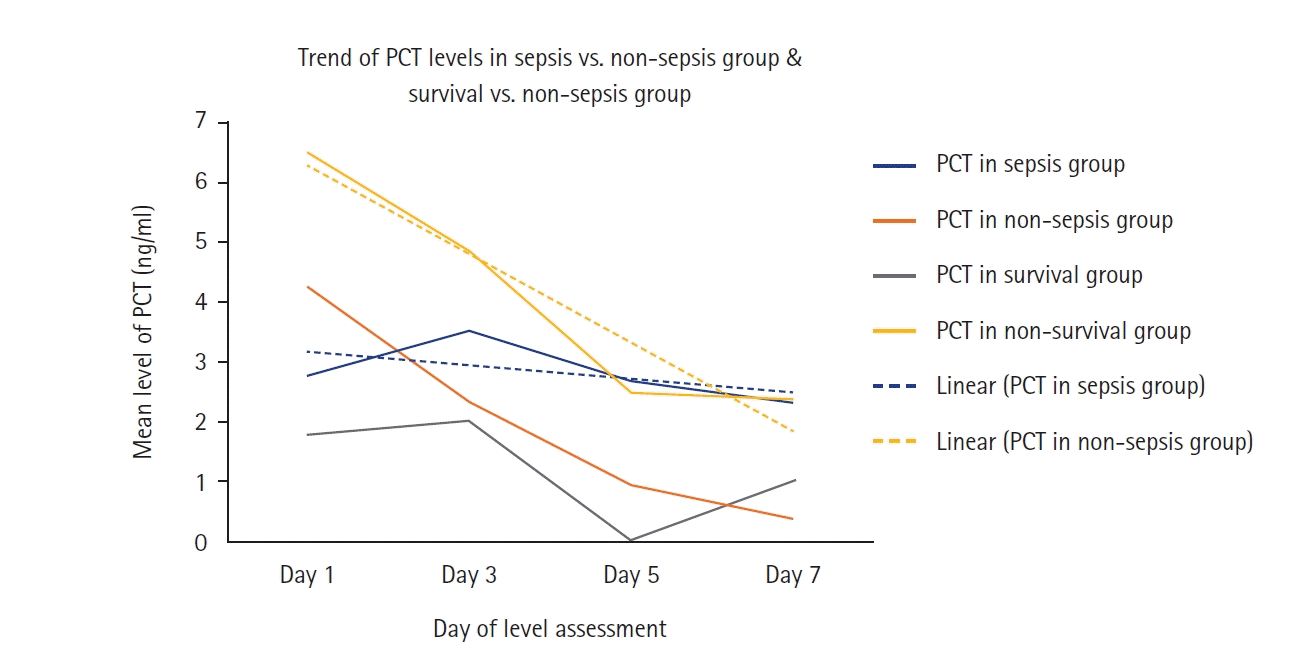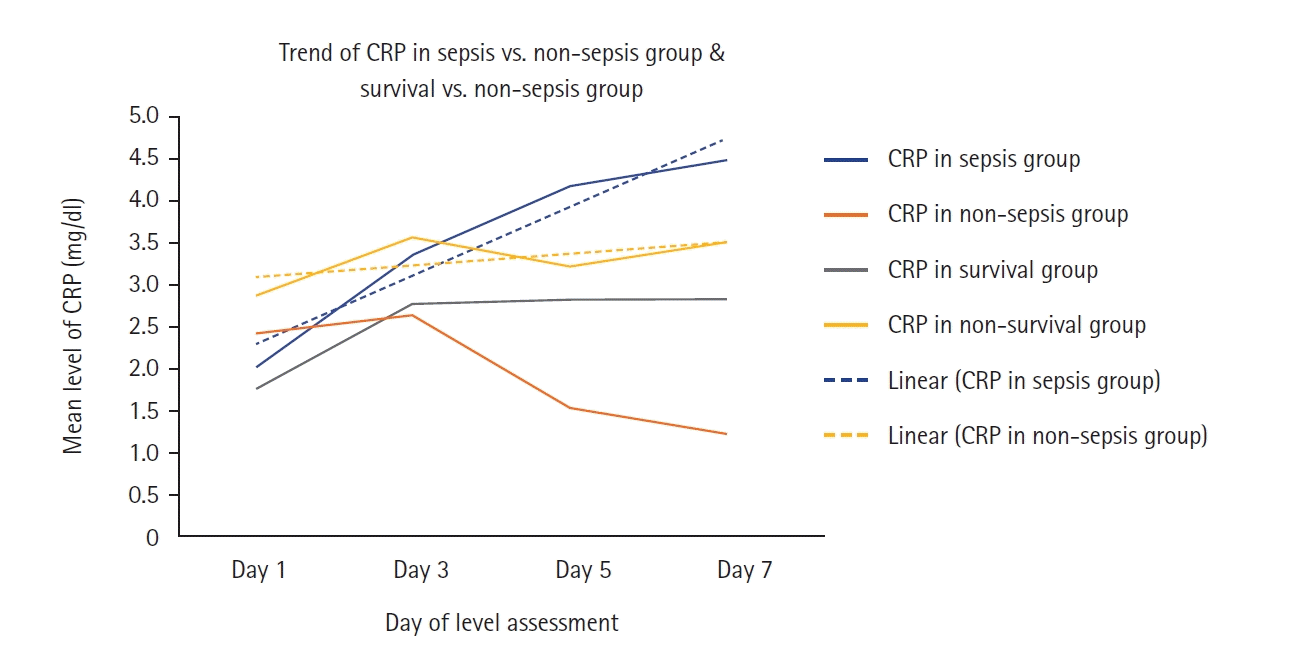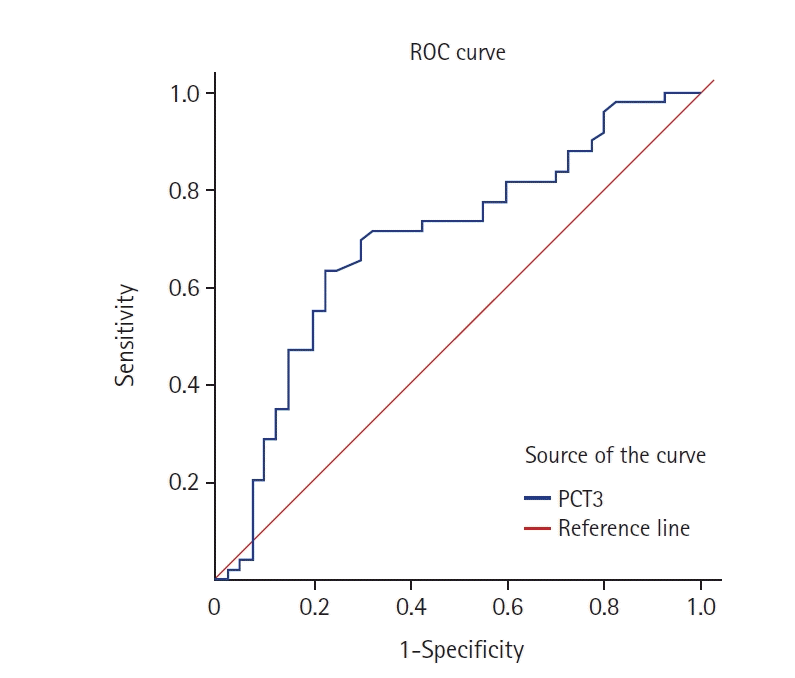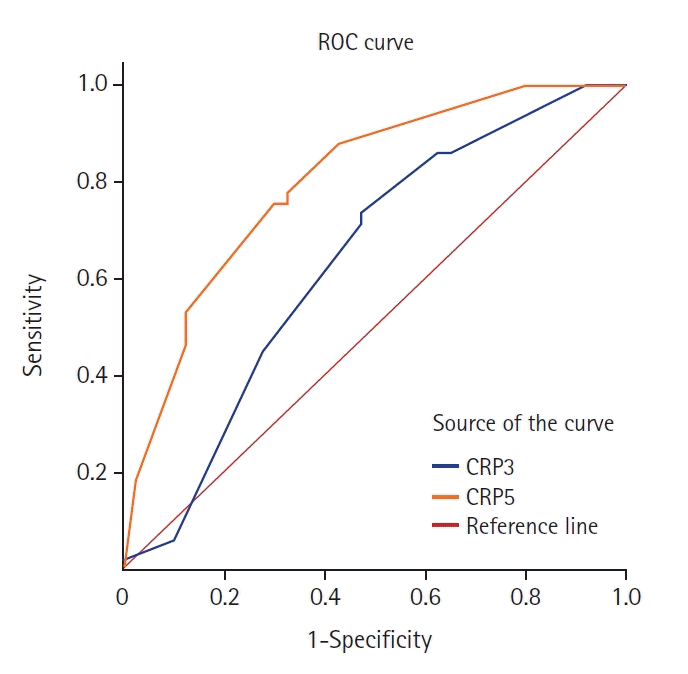1. Burd A, Yuen C. A global study of hospitalized paediatric burn patients. Burns. 2005; 31:432–8.
2. Sengoelge M, El-Khatib Z, Laflamme L. The global burden of child burn injuries in light of country level economic development and income inequality. Prev Med Rep. 2017; 6:115–20.
3. Greenhalgh DG, Saffle JR, Holmes JH, Gamelli RL, Palmieri TL, Horton JW, et al. American Burn Association consensus conference to define sepsis and infection in burns. J Burn Care Res. 2007; 28:776–90.
4. Greenhalgh DG. Sepsis in the burn patient: a different problem than sepsis in the general population. Burns Trauma. 2017; 5:23.
5. Martinez R, Rode H. Role of procalcitonin in paediatric burn wound sepsis. S Afr Med J. 2018; 108:793–4.
6. Barati M, Alinejad F, Bahar MA, Tabrisi MS, Shamshiri AR, Bodouhi NO, et al. Comparison of WBC, ESR, CRP and PCT serum levels in septic and non-septic burn cases. Burns. 2008; 34:770–4.
7. Mann EA, Wood GL, Wade CE. Use of procalcitonin for the detection of sepsis in the critically ill burn patient: a systematic review of the literature. Burns. 2011; 37:549–58.
8. Lavrentieva A, Papadopoulou S, Kioumis J, Kaimakamis E, Bitzani M. PCT as a diagnostic and prognostic tool in burn patients: whether time course has a role in monitoring sepsis treatment. Burns. 2012; 38:356–63.
9. Pruchniewski D, Pawlowski T, Morkowski J, Mackiewicz S. C-reactive protein in management of children's burns. Ann Clin Res. 1987; 19:334–8.
10. Neely AN, Smith WL, Warden GD. Efficacy of a rise in C-reactive protein serum levels as an early indicator of sepsis in burned children. J Burn Care Rehabil. 1998; 19:102–5.
11. Jeschke MG, Finnerty CC, Kulp GA, Kraft R, Herndon DN. Can we use C-reactive protein levels to predict severe infection or sepsis in severely burned patients? Int J Burns Trauma. 2013; 3:137–43.
12. Rosanova MT, Tramonti N, Taicz M, Martiren S, Basílico H, Signorelli C, et al. Assessment of C-reactive protein and procalcitonin levels to predict infection and mortality in burn children. Arch Argent Pediatr. 2015; 113:36–41.
13. Abdel-Hafez NM, Saleh Hassan Y, El-Metwally TH. A study on biomarkers, cytokines, and growth factors in children with burn injuries. Ann Burns Fire Disasters. 2007; 20:89–100.
14. Neely AN, Fowler LA, Kagan RJ, Warden GD. Procalcitonin in pediatric burn patients: an early indicator of sepsis? J Burn Care Rehabil. 2004; 25:76–80.
15. Hollén L, Hughes R, Dodds N, Coy K, Marlow K, Pullan N, et al. Use of procalcitonin as a biomarker for sepsis in moderate to major paediatric burns. Trauma. 2019; 21:192–200.
16. Kundes MF, Kement M. Value of procalcitonin levels as a predictive biomarker for sepsis in pediatric patients with burn injuries. Niger J Clin Pract. 2019; 22:881–4.
17. Cabral L, Afreixo V, Almeida L, Paiva JA. The use of procalcitonin (PCT) for diagnosis of sepsis in burn patients: a meta-analysis. PLoS One. 2016; 11:e0168475.
18. Mokline A, Garsallah L, Rahmani I, Jerbi K, Oueslati H, Tlaili S, et al. Procalcitonin: a diagnostic and prognostic biomarker of sepsis in burned patients. Ann Burns Fire Disasters. 2015; 28:116–20.
19. Avni T, Levcovich A, Ad-El DD, Leibovici L, Paul M. Prophylactic antibiotics for burns patients: systematic review and meta-analysis. BMJ. 2010; 340:c241.
20. Wibbenmeyer L, Danks R, Faucher L, Amelon M, Latenser B, Kealey GP, et al. Prospective analysis of nosocomial infection rates, antibiotic use, and patterns of resistance in a burn population. J Burn Care Res. 2006; 27:152–60.
21. Mukerji G, Chamania S, Patidar GP, Gupta S. Epidemiology of paediatric burns in Indore, India. Burns. 2001; 27:33–8.
22. Oncul U, Dalgıç N, Demir M, Karadeniz P, Karadağ ÇA. Use of procalcitonin as a biomarker for sepsis in pediatric burns. Eur J Pediatr. 2023; 182:1561–7.
23. Duke J, Wood F, Semmens J, Edgar DW, Spilsbury K, Hendrie D, et al. A study of burn hospitalizations for children younger than 5 years of age: 1983-2008. Pediatrics. 2011; 127:e971–7.
24. Ozkan GY, Yucel T. Burn, introduction, epidemiology, etiology. Turkiye Klin J Surg Med Sci. 2007; 3:1–3.
25. Peddi M, Segu S, Ramesha KT. The persistent paradigm of pediatric burns in India: an epidemiological review. Indian J Burn. 2014; 22:93–7.
26. Dhopte A, Bamal R, Tiwari VK. A prospective analysis of risk factors for pediatric burn mortality at a tertiary burn center in North India. Burns Trauma. 2017; 5:30.
27. Reinhart K, Karzai W, Meisner M. Procalcitonin as a marker of the systemic inflammatory response to infection. Intensive Care Med. 2000; 26:1193–200.
28. Arora S, Singh P, Singh PM, Trikha A. Procalcitonin levels in survivors and nonsurvivors of sepsis: systematic review and meta-analysis. Shock. 2015; 43:212–21.
29. Bouadma L, Luyt CE, Tubach F, Cracco C, Alvarez A, Schwebel C, et al. Use of procalcitonin to reduce patients' exposure to antibiotics in intensive care units (PRORATA trial): a multicentre randomised controlled trial. Lancet. 2010; 375:463–74.
30. Póvoa P. C-reactive protein: a valuable marker of sepsis. Intensive Care Med. 2002; 28:235–43.
31. Deepashree G, Rao C, Rau AT. Procalcitonin as marker of the severity of sepsis in critically ill children. Indian J Child Health. 2016; 3:102–5.
32. Solé-Ribalta A, Bobillo-Pérez S, Valls A, Girona-Alarcón M, Launes C, Cambra FJ, et al. Diagnostic and prognostic value of procalcitonin and mid-regional pro-adrenomedullin in septic paediatric patients. Eur J Pediatr. 2020; 179:1089–96.
33. Sachse C, Machens HG, Felmerer G, Berger A, Henkel E. Procalcitonin as a marker for the early diagnosis of severe infection after thermal injury. J Burn Care Rehabil. 1999; 20:354–60.
34. Lubis M, Lunis AD, Nasution BB. The usefulness of C-reactive protein, procalcitonin, and PELOD-2 score as a predictive factor of mortality in sepsis. Indones Biomed J. 2020; 12:85–188.
35. Siddiqui I, Jafri L, Abbas Q, Raheem A, Haque AU. Relationship of serum procalcitonin, C-reactive protein, and lactic acid to organ failure and outcome in critically ill pediatric population. Indian J Crit Care Med. 2018; 22:91–5.
36. Malluvalasa S, Arigela V, Lanka S, Padala S. Comparative study of procalcitonin versus c-reactive protein in the diagnosis of sepsis in children below 16 years-a single centre observational study. J Pediatr Res. 2017; 4:68–75.
37. Rey C, Los Arcos M, Concha A, Medina A, Prieto S, Martinez P, et al. Procalcitonin and C-reactive protein as markers of systemic inflammatory response syndrome severity in critically ill children. Intensive Care Med. 2007; 33:477–84.
38. Prat C, Domínguez J, Rodrigo C, Giménez M, Azuara M, Blanco S, et al. Use of quantitative and semiquantitative procalcitonin measurements to identify children with sepsis and meningitis. Eur J Clin Microbiol Infect Dis. 2004; 23:136–8.
39. Sharma R, Sharma J. Role of C reactive protein in pediatric sepsis. Int J Healthc Biomed Res. 2018; 6:57–63.
40. Permatasari AA, Sanjaya IG, Widiana IG, Niryana IW, Asmarajaya AA, Hamid AR, et al. Role of procalcitonin and C-reactive protein as marker of sepsis in major burn patients: a systematic review and meta-analysis. Open Access Maced J Med Sci. 2021; 9:197–203.
41. Angulo M, Moreno L, Aramendi I, Dos Santos G, Cabrera J, Burghi G. Complete blood count and derived indices: evolution pattern and prognostic value in adult burned patients. J Burn Care Res. 2020; 41:1260–6.
42. Qiu L, Jin X, Wang JJ, Tang XD, Fang X, Li SJ, et al. Plasma neutrophil-to-lymphocyte ratio on the third day postburn is associated with 90-day mortality among patients with burns over 30% of total body surface area in two Chinese burns centers. J Inflamm Res. 2021; 14:519–26.
43. Lin JC, Wu GH, Zheng JJ, Chen ZH, Chen XD. Prognostic values of platelet distribution width and platelet distribution width-to-platelet ratio in severe burns. Shock. 2022; 57:494–500.
44. Rajagopal P, Ramamoorthy S, Jeslin AG. Utility of haemogram parameters in mortality risk prediction of critically ill patients. J Evol Med Dent Sci. 2018; 7:1024–9.
45. Mısırlıoğlu M, Bekdas M, Kabakus N. Platelet-lymphocyte ratio in predicting mortality of patients in pediatric intensive care unit. J Clin Anal Med. 2018; 9:488–92.
46. Can E, Hamilcikan Ş, Can C. The value of neutrophil to lymphocyte ratio and platelet to lymphocyte ratio for detecting early-onset neonatal sepsis. J Pediatr Hematol Oncol. 2018; 40:e229–32.
47. Dursun A, Ozsoylu S, Akyildiz BN. Neutrophil-to-lymphocyte ratio and mean platelet volume can be useful markers to predict sepsis in children. Pak J Med Sci. 2018; 34:918–22.
48. Mathews S, Rajan A, Soans ST. Prognostic value of rise in neutrophil to lymphocyte ratio (NLR) and platelet to lymphocyte ratio (PLR) in predicting the mortality in paediatric intensive care. Int J Contemp Pediatr. 2019; 6:1052–8.
49. Fuss J, Voloboyeva A, Poliovyj V. Prognostic value of using neutrophil-lymphocyte ratio in patients with burn injury for the diagnosis of sepsis and bacteraemia. Pol Przegl Chir. 2018; 90:13–6.
50. Ciftci A, Esen O, Yazicioglu MB, Haksal MC, Tiryaki C, Gunes A, et al. Could neutrophil-to-lymphocyte ratio be a new mortality predictor value in severe burns? J Surg Surg Res. 2019; 5:26–8.








 PDF
PDF Citation
Citation Print
Print



 XML Download
XML Download